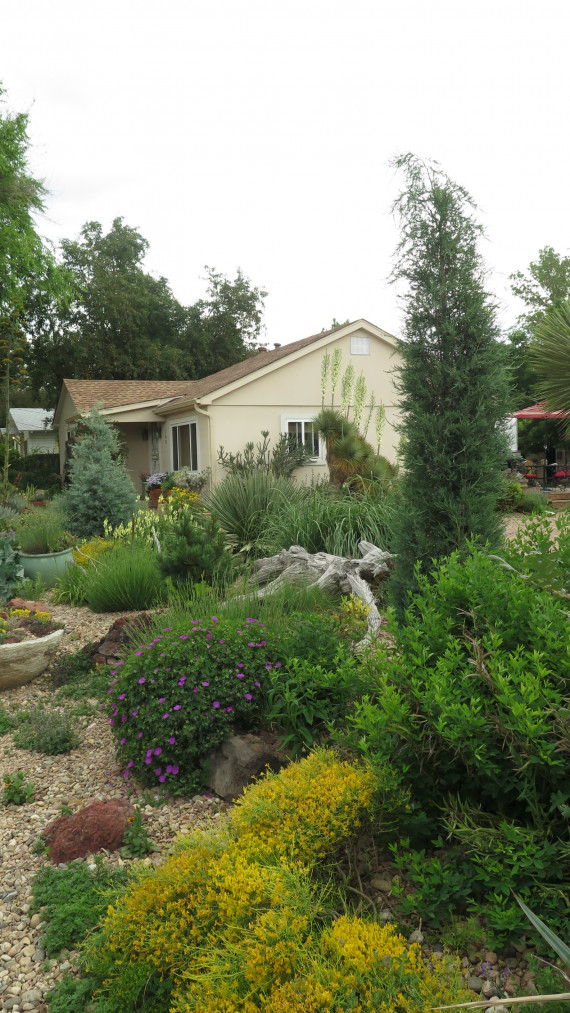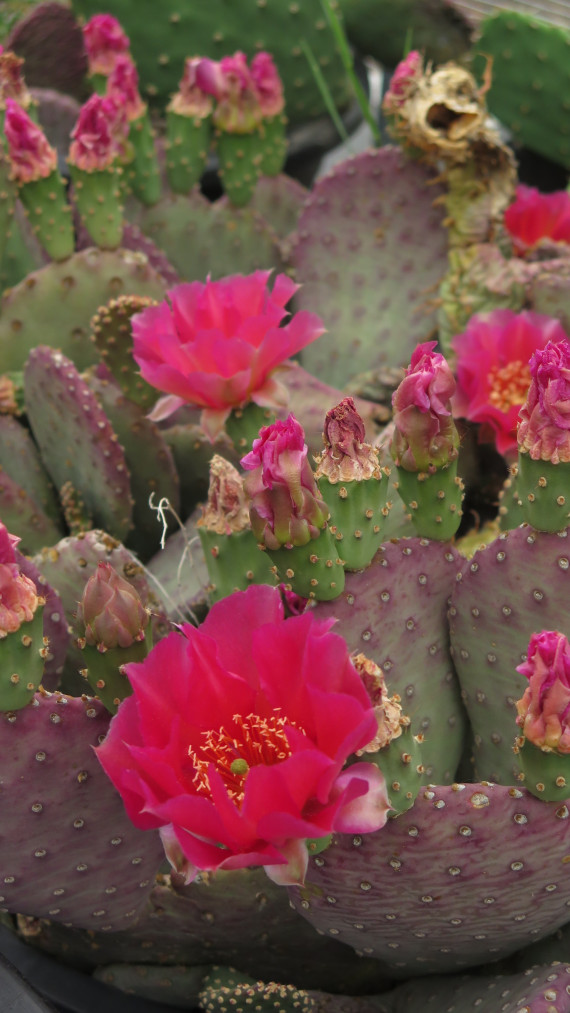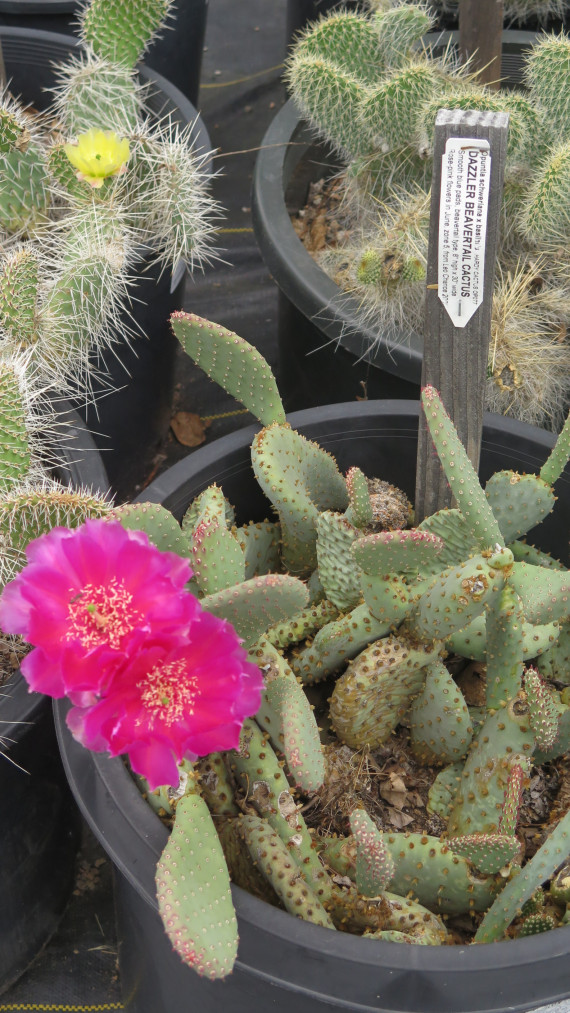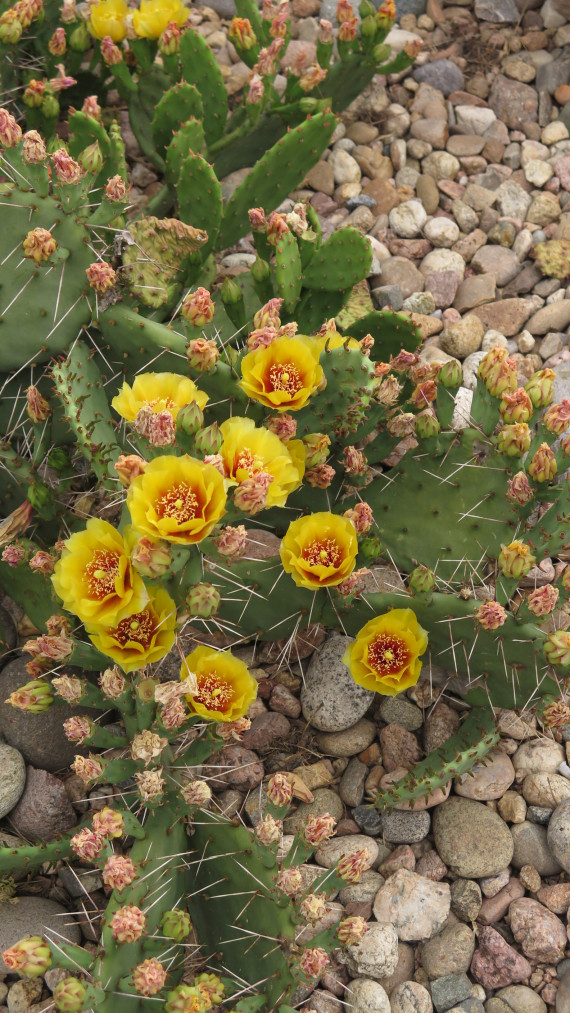Part of the delight in growing hardy cactus, for me anyway, comes in not having to move pot-grown specimens into the conservatory as the temperature drops. The hardy sorts of opuntia (aka prickly pear cactus) are especially attractive and common throughout the intermountain and prairie regions of the West. Opuntia aurea, hardy from Zone 5-10, is the one most often encountered, growing low but spreading wide, making a mat six inches tall by three feet wide. Often camouflaged by surrounding plants, it pops in the landscape when its bright yellow or pink flowers open wide to welcome bees and other foragers.

Kelly Grummons, a Denver-based cactiphile has made a specialty of developing a range of opuntias that flower extravagantly over a long season. As Dan Johnson of the Denver Botanic Garden observed for The American Gardener magazine, “[he] has taken the simple prickly pear where no opuntia has gone before, creating spectacular hybrids with amazing flower power with his Walk in Beauty™ series.” This is an assortment Grummons developed from a small-padded selection of the native O. aurea that, after growing in his rock garden for several years, turned out to be an all-summer bloomer. Naming it “Golden Carpet”, it was the progenitor of the hybrids he now markets through his Cold Hardy Cactus nursery in Lakewood, Colorado. On a garden-open visit there with the Colorado Native Plant Society, I acquired a few Walk in Beauty™ beauties to add to my developing rock garden.

But Grummons is not the first in our neck of the woods to realize the value of the humble but hardy prickly pear; in the mid-1980s he met up with Mary Ann Heacock, who he dubs the “Opuntia Queen”, and with her traveled across the plains and mountains west of the Mississippi hunting the prickly pear. Some of their finds entered our gardens—O. heacockiae commemorates Mary Ann, and who wouldn’t want to grow a plant named ‘Wavy Gravy’?
Writing an account for The Rock Garden Quarterly, of his evolution as a cactus breeder, Grummons also credits the collections of Claude Barr, “one of the first horticulturists to focus on the hardy native plants of the northern plains”; Mary Ann Heacock had many of Barr’s plants and Grummons added their genes of hardiness and flower quality to his opuntia breeding program. Since then, many other opuntia specialists have contributed to the Cold Hardy Cactus nursery’s program.

The architectural quality of the cacti’s many forms make it an extremely welcome addition to native gardens, which can look rather ethereal with all the small flowers and wispy grasses. The cacti’s bold shapes and vibrant flowers add substance and are a flamboyant gesture to more systematically designed, contemporary gardens favoring the stripped-down modernist look. And their flowers are a definite draw for bees and hummingbirds, so they have a place in habitat gardens, too. Well-drained, gritty soil to give sharp drainage at the base, full sun and a surface dressing of gravel mulch are required when planting out in the garden or in troughs or pots.

For gardeners who prefer not to be wounded by their plants, there are spineless sorts, because there’s no doubt that many gardeners are deterred by the spines; it’s not so much the obvious spiny needles that are the drawback, but the insidious nature of the miniscule glochids, clustered in fuzzy bundles at the base of each spine. They’ll get you no matter how tough your gauntlet gloves are (as I discovered). Distance is your friend, so metal kitchen tongs to lift and position for planting are required, and offer the some protection. Although, I am told that Kelly Grummons’s best advice is “Don’t go near them.”
©Text and photos, Ethne Clarke, 2019.
To learn about Kelly Grummons and his nursery, visit https://coldhardycactus.com/
The Colorado Native Plant Society can be found at https://conps.org/
For information about growing hardy cactus and opuntia in particular look for the articles:
Stunning Winter-Hardy Cactus: The Opuntia, Kelly Grummons, The Rock Garden Quarterly, Spring 2019, 103-111, North American Rock Garden Society.
Ruggedly Elegant Prickly Pears, Jessie Keith, The American Gardener, May-June 2019, 26-31, The American Horticultural Society.


